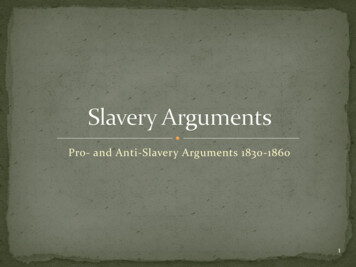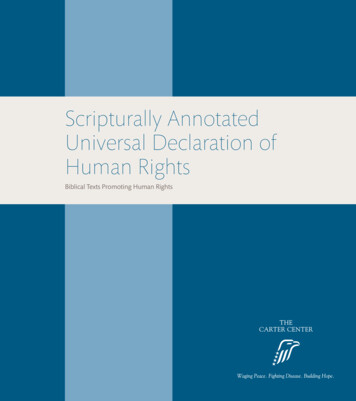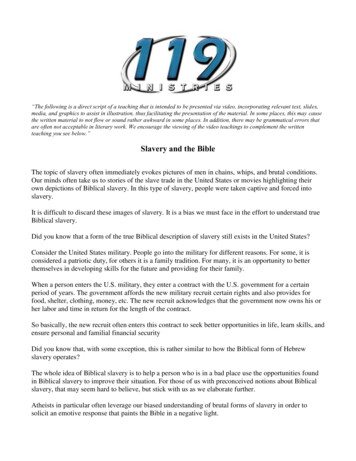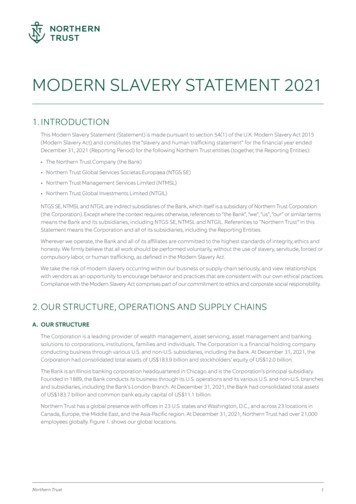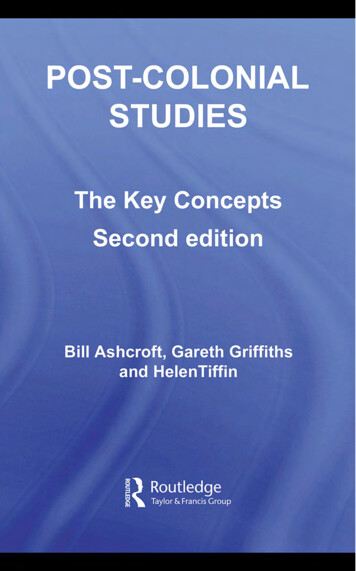
Transcription
The Overthrow ofColonial Slavery1776-1848-------- -------ROBIN BLACKBURNVVERSOLondon New York
ContentsList of Maps 'AcknowledgementsIntroduction; Colonial Slavery in the Neyv World c. 1770I . The Origins of Anti-Slavery133II-Hanoverian Britain: Slavery and EmpireIIISlavery and the American Revolution109IVBritish Abolitionism and the Backlash of the 1790s131The French Revolution and the Antilles; 1789-93161Revolutionary Emancipationism and the Birth of Haiti213VIIAbolition and Empire; The United States265VIIIBritish Slave Trade Abolition: 1803—14293Spafiish America: Independence and Emancipation331W\/ VIIXCuba and Brazil: the Abolitionist Impasse67 1XIThe Struggle for British Slave Emancipation: 1823-38419XIIFrench Restoration Slavery and 1848473XIIIConclusion: Results and ProspectsIndex -517551
Introduction:Colonial Slavery in theNew World c. 1770Behold the peace that’s owned by him who feelsHe does no wrong, or outrage when he dealsIn human flesh; or yet supplies the goldTo stir the strife, Svhose victims you behold . . .Perhaps the Cuban merchant too, may thinkIn guilt’s great chain he’s but the farthest link.Forsooth, he sees not* all the ills take place.Nor goes in person to “the human chase;He does not hunt the negro down “himself;Of course he only furnishes the pelf.He does not watch the blazing huts beset.Nor slips the horde at rapine’s yell, nor yetSelects the captive from the wretched bandNor spears the aged with his right hand . . .He does not brand the captives fot the mart.Nor stow the cargo - ’tis the captain’s flart . . .His agents simply snare the victims first.They make the war and he defrays the cost . .To human suffering, sympathy and shame.His heart is closed, and wealth is all his aim.The Slave-Trade Merchant (1840), R.R. Madden1
The Caribbean in 1770: see also p. 32IntroductionAround the year 1770 there were nearly two and a half million slavestoiling in the fields, mills, mines, workshops and households of the NewWorld colonies. Slave labour supplied the most coveted and importantitems in Atlantic and European commerce: the sugar, coffee, cotton andcacao of the Caribbean; the tobacco, rice and indigo of North America;the gold and sugar of Portuguese and Spanish South America. Thesecommodities comprised about a third of the value of Europeancommerce, a figure inflated by regulations that obliged colonialproducts to be brought to the metropolis prior to. their re-export toother destinations. Atlantic navigation and European settlement of theNew World made the Americas Europe’s most convenient and practicalsource of tropical and sub-tropical produce. The rate of growth ofAtlantic trade in the eighteenth century had outstripped all otherbranches of European commerce and created fabulous fortunes. Yet thisimposing nexus of empire and slavery was about to enter a terminalcrisis.The period 1776—1848 witnessed successive challenges to fhe regimesof colonial slavery, leading to the destruction either of the colonialreUtionship,,or of the slave system, or of both, in one after another ofall the major New World colonies. The contestation of empire and thecontestation of slavery were, in principle, dissimilar and distinctprojects. Yet in this period they became intertwined, as colonists’resisted imperial rule and as the slaves themselves sought to exploit anyweakening in the apparatus of social cpntrol. All the cdlonial powerspermitted slavery and all the slave systems were integrated within ofle'or other of the transatlantic empires. Large-scale plantation slavery haddeveloped in the seventeenth century Caribbean as a result of privateenterprise and freelance initiative; after a few decades of virtualautonomy the planters had acquired the interested protection ofEngland or France, powers which had the naval strength to keepmarauding pirates, privateers and colonial rivals at bay. The new slavesystems developed within a colonial shell and generated largecommercial profits and customs revenues for the imperial metropolis.But for the plantations to prosper, the imperial authorities had to resistthe temptation of over-regulating and over-taxing the plantationcommerce.Tlje structures of empire were more immediately vulnerable thanthose.y.of srav lsubiugation and explol on. Slaveholder power w concentrated in the Americas; imperial power was strung out acrossoceanic sea-lanes and depended on the more or less willing allegianrp nfthe possessing classes in thexolonies. As European settler populationsreproduced themselves across generations th devJopeS institutionsand resources which reduced reliance on the metronolis.the lan r
IntroductionThe Overthrow of Colonial Slaveryhalf of the eighteenth century colonial elites throughout the Americaswere acquiring greater self-confidence, whether they were involved inslaveholding or not. The buoyancy of Atlantic trade was such that thecommercial monopolies were bursting at the seams in 1770. In theaftermath of the Seven Years War (1756—63) all of the imperial powersrecognised the pressure for greater colonial autonomy and sponsoredprojects of reform. The colonial challenge to metropolitan officials andmerchants represented an aspiration-to-selfi overnment: it was at once a claim to greater economic freedom and an assertion of an embryonicnew American identity and civilisation. American demands for libertyand self-determination strengthened attacks on oligarchy and arbitraryrule in the Old World. Yet rejection of the political regimes of the OldWorld did not necessarily imply fundamental changes in social institutions. One of the aims of this book is to find out why the crisis inthe modp r»f iol'tirardnmihafionlsametimes-detonated a crisis of thesocial regime, especially the institution of slavery.Ihis introduction aims to give a sketch ot the colonial slave systemsof the mid-eighteenth century, establishing their characteristic strengthsand weaknesses, on the eve of that ‘Age of Revolution’ in which theywere ’to play a highly significant role.The systems of mercantilist control sought to direct colonial trade, andengaged t s of thousands of officials to this end. Britain permitted a ecies of imperial free trade and did not at all respect the colonialmonopolies of its rivals. French merchants were allowed to re-exportplantation produce free of'duty and received a bounty for the slavesthey sold to the planters in the Antilles. The royal bureaucracies ofSpain and Portugal asserted direct control of the silver and goldproduced in their American possessions. Colonial monopolies inprinciple enabled metropolitan merchants to skim off a surplus andimpede inter-American trade. But the very vigour of Atlantic commercetended to overspill the prescribed boundaries. Smuggling is likely tohave accounted for at least a tenth of all trade despite the customs andexcise officials and the regular naval patrols. Notwithstanding Portugal’sweakness, and the trading concessions extended to Britain, themerchants of Lisbon and Oporto held their own in the Brazil trade,even if this meant selling British textiles for Brazilian gold. By the 1760sthe main' raison d’etre of the Dutch islands was as centres forunregulated commerce.The different patterns of colonial development produced the divisionby territory of the New World slave population in 1770 set out in Table1 below.4Table 1 Estimated- Slave Populations of the American Colonie l770British America(British North America)(British Caribbean)Portuguese America (Brazil!French America (CanFBean)Spanish America(Spanish Caribbean)(Spanish Mainland) Dutch CaribbeanDanish CaribbeanSlavesTotal Population878,000(450,000)(428,000) 44,000(144,000)(12,000,000)90,00025,000The size of the colonial slaveholdings did not reflect either thegeographical size of the different empires or priority in colonisation.Spain, the first and still the largest colonial power in the New World,ranked only fourth as a slaveholding power. Britain and France, whichhad no slave colonies in 1640, now possessed the most flourishing slaveplantations in the New World. The total slave population of Brazil mayhave been larger than that of the French colonies, but the estimate isuncertain and slavery was somewhat less concentrated in the exportsector. Brazil was a colony of Portugal, but Portugal was almost a semi colony of Britain so that much of Brazil’s slave-produced gold came toLondon. Britain and France had the commercial vigour to create themost productive slave colonies even if the Iberian powers still held swayover immense mainland empires. And, in contrast to the Netherlands,Britain and France had been able to mobilise the requisite strength todefend their colonial conquests in the New World. Though capitalistsocial relations were more highly developed in Britain than in France,the vigorous,, development of French commerce and manufacture in theeighteenth century nevertheless ran Britain a close second. Frenchexports of refined sugar or of cotton manufactures exceeded those ofBritain in the 1760s; cheap colonial raw materials, supplied underspecial privileges and exemptions, helped to make possible an enclave ofaccumulation that employed wage labour.The use, of African slaves had enabled Britain to vault to the premierposition as an American colonial power, developing its Americanpossessions until their exports overtook those of Spanish America. Bythe 1770s the slave colonies of the French Antilles were bidding to/Overtake the British West Indiesr ihe annual value of colonial exjiorts5
IntroductionThe Overthrow of Colonial Slavery 5dletb 4da-theJJlktem.&!ghslLColoniusJgOi2rth Anleri jnJh J.2 or in the French Antilles in 1788-93j orJnJ aiezudaJtoJi:anada PTTiTanTRrd'irirTTafriHT and 1820s. Thejaveholders of B idiTand of the rTEIsTrana pamslrC their cards m adifferent way, avoiding upheaval so far as possible but making theirpresence felt all the same. American slaveholders in this period weredistinctly less conservative than the wealthy and powerful elsewhere;whether mine-owners in Mexico or landowners m Europe. Someobservations on the character of the slavery found in the Americas ofthis epoch will help explain this.in the early 1770s amounted to 5.6 million (or the British colonies 5 2 million for the French colonies, 1.8 million for Brazil and .million for the whole of Spanish America. British merchants andmanufacturers held a larger lead in supplying colonial markets; theirexports to the Americas as a whole were at least twice as great as thoseof the French. Transatlantic commerce required approximately halt amillion tons of shipping and employed more than a hundred thousandseamen and dock-workers. Britain’s profits on the Atlantic trade derivedchiefly from the effective capitalist organisation of marine transportmanufacturing supply and commercial finance; French commerciaprofits, which in gross amounted to a half of the colonial export trade,were more dependent on mercantilist monopoly.In the mid-eighteenth century Britain and France were according towidespread contemporary testimony, the most powerful,splendid and the most dynamic states m the world. In their differentways Versailles and Westminster were the exemplarythe age. Following PoaagaUSpaim-and. h J i established a WoridwidTnetwork of ookmies ajidjadmg The species of slavery that prevailed in the Americas in the eighteenthcentury should not be seen as a relic of the Ancient or medieval world.The colonial systems were of very recent construction and were highlycommercial in character. They spanned an ocean and were locked mrivalry. The slaves were drawn exclusively from Africa and the greatmajority of them were subjected to harsh labour regimes. By .contra .,previous forms of slavery iiadLjKeiiiess„iarJluog,Ja .ggBlIBSr ial.A —moreheterogenfious. The slaves of the New World were ecoirommproperty and the main motive for slaveholding was economic"Iqe'w ArldwarAouglutrb the crucial testing ground by suchleading statesmen as Pitt the Elder and Choiseul. Even the Abbe Raynalwho endorsed the new philosophical critique of slavery, believed thatsugar plantations had replaced gold mines as the sinews of empire. Inhis Histoire des Deux Indes (1770) Rayna urged the Spam hauthorities to promote the plantation economy of Cuba so that it couldrival the achievements of the Virginian planters, who supplied allEurope with tobacco, or those of the planters of St Dommgue, whom this end at least nine tenths of Amgncan skwes were ut, to commodity production .,supplied half of Europe with sugar.The Atlantic and Caribbean loomed large in eighteenth century wars Britain and France protected their empires with navies that comprisedsixty to eighty ‘ships of the line’ each, with a swarm ’Spain’s naval forces were only a little smaller and included the rffectiveguardacostas of the Caribbean. The Netherlands, defeated m Brazil mthe seventeenth century, was only a minor American power. British andFrench conquests in the Caribbean were onlyfVdeployment of massive naval power and the availability of a ste ystrLm of emigrants. After the Treaty of Ryswick m 1697 there hadbeen few territorial changes in the Caribbean but the threat was there.However, by 1770 an imEortantjmnmg nt had been BSiiSRwriilijheAeien Year Mln l d erejec heFromUhTtime f5maa[Mn upH l h fi l . .sTa holders weTTiTpItylTii i 7In other societies slavery has had a chameleon-like ability to adapt tothe surrounding social formation; like a social false limb it has extendedthe powers of slaveholders in forms appropriate to the given society perhaps enlarging a lineage or supplying a trusted core of administra tors. In the eighteenth century Americas the use of slaves in agriculture 1and mining helped to extend the scope of mercantile and manufacturing jcapital and supplied industrialising regions with needed inputs and outlets. Elizabeth Fox Genovese and Eugene Genovese have identified the impulse to mercantile.,a CUnudatiflil3&Ahe,. ropuEive forcgbdunj jHTf-rise of the new slave svstema. The New World partnership ofmerchants and planters led to the creation of an integrated manufactur ing and agricultural enterprise. The slave plantations themselvesincorporated those advances in agricultural technique compatible withco-ordinated gang labour. The entrepreneurs directing them wereusually willing to adopt innovations in processing methods and theyhad the resources to purchase the products of capitalist industry andcommercial farmirjg. The New World planter, purchasing inputs inpartial exchange for the commodities supplied, could increase output inresponse to market pressures far more rapidly than the feudal lords of7
IntroductionThe Overthrow of Colonial SlaveryEastern Europe and on the basis of greater complementarity withmanufacturing capital. The plantation itself embodied a feat ofproductive organisation and invigilation. The slave gangs m the fieldand the slave teams in the mills were mobilised for labour that wascoerced, intensive and continuous. Manuel Moreno Fraginals hasexplored the ways in which the sugar mills anticipated some of themethods of an emergent capitalist industrialism, with calibration of labour inputs and subordination to mechanical rhythms.The tightly coordinated labour process of the late eighteenth century sugap ‘plantation’hah resemWed the industrial‘plant’ of the future.Yet these Marxist autHms rightly distmgujsh-b tw. n. .ey slaverr’anr-TTegimi rgen iiili ehoTclmg enfHF serrtilT 53‘?5msjn ; 2iHabstf Slaves grew much of their own food, builtytheirjpwaJTatS-a -tM 1 the market. l he sla planbatiooIiajSd suan ujadv, ’y Ib TiKTwrsuBsistS and manufacflu: The fact thafplMters'had'this ‘reser 'oTMmmr as Jacobo Gorender hascalled it, reinforced their Capacity to survive times of war, revolution orcommercial depression. Like the peasant or farmer, and unlike themanufacturer or merchant, the planter could withdraw from the market .for long periods and keep his enterprise m being. But he was not bound,/ in phases of expansion, to the resources of the estate; with beckoningmarkets his prospects were limited only by his capacityto b slaves,supplies and equipment as needed. Europeanfeudal serf-lords, by contrast, were hemmed m by natural econoinyand constrained by the given size of the family or estate labour availableto them. The capital tied up in his plantation meant that the planter wasnot prone to relapse into autarchy. Building and maintaining aplantation entailed ongoing economic costs which acted as a spur torenewed commodity production as soon as it was possible, andeconomic value of slaves was such that the planter who could not makea profit out of them himself was induced to sell them to someone whowLld. Once again neither the peasant nor the serf-lord was subject tocomparable economic pressure. Since the slaves covered their subsis tence needs in only two days labour each week, including nearlytheir sparse ‘free time’, the rate of surplus extraction and gross profitwas very high. The slaveholding planter was thus an entrepreneur witboth the ability and the motive to be responsive to market pressuresThe expansion of supply depended only on the cost of clearing land, ofacquiring slaves and equipment, and of paying salaried supervisors.Europe’s craving for exotic commodities was such that these costs couldbe amply met.'*, rcThe characterisation offer dJi i: -i eJ:s-lxL.the, pK.«MmnaaLIQtm-Q Am HT Tskverv iT eighteenth-century. In Spanish America andf5Jtuguese’"Brazil there w also residues of an earlier, more diffusepattern. It is necessary to distinguish between the ancdlary slavery ofearly Spanish or Portuguese colonialism and the systemic slavery, linkedto plantations and commodity production, which was dominant by theeighteenth century. The ‘ancillapL§la3 J:y - -* P * colonies with slave majorities or the. xdu§.io.n oLgJayesJgm- fg5bbHiIBFlF5iS nhiiSiir um.an- 'TheiiSSHmimi of slaves helped to consolidate an imperial superstructure y of exploitation that was not mainly based on slave labour. Spanishwealth and power derived from the conquest and exploitation of theindigenous peoples of the continent; outright enslavement of theAmerindians was tried but proved either impossible or so destructive asto be counter-productive. The Indian communities of the sixteenthcentury Caribbean islands and littoral had been disrupted anddemoralised by invasion and overwork; their peoples were destroyed byappalling epidemics, or were absorbed as the conquerors took Indianwomen. Some fled to inhospitable and marginal swamps, or held out onrocky islands and in jungle backlands. But on the mainland the Spanishconquerors were able to substitute themselves for the previous rulingstrata of the Inca and Aztec empires, exploiting Indian communitiesthat were subjugated but not enslaved.Captive Africans had been introduced to Spanish America to makeup for de-population of the worst-hit areas and to strengthen thepresence of the colonising power; to sustain centres of administrationand lines of communication and to serve the personal needs of theconquerors. The eighteenth century use of slaves in Spanish Americaretained some of this long-established pattern. African slaves worked asidomestics, porters, foremen, dockers, seamstresses, barbers, gardeners,/artisans; slaves did toil in gold mines in New Granada, and on sugarestates in Cuba or cacao groves in Venezuela, but these were stillfairly modest enclaves in the Spanish imperial economy of 1770. Itssilver was mined by wage workers, mostly of Indian extraction but withsome blacks or mestizos, or by tribute labour from the Indian villages.Imperial administration in Spanish America directly promoted and coordinated economic activity; royal administrators supervised the supplyof food and labour to the mines, allotted mining concessions, purchasedtobacco and took charge of the flow of silver back to Europe. Therewere leaks, of course, but this extensive system of imperial exploitation/9s
IntroductionThe Overthrow of Colonial Slaverycontrasted with the intensive regime of micro-exploitation on *e slaveplantations elsewhere in the Americas. It also helped to inhibit thecreole elite who were well aware that the imperial state was a direct andcrucial factor in their extraction of surplus labour from the underlyingproducers. By contrast planters directed a self-contained process ofsurplus extraction, with the colonial state stepping m to levy taxes,establish awkward regulations and furnish external protection. TheSnanish American silver mines in the ITTOsjyerejnddm i thirmiJ Wii r erican min colonial autonomy than was j .„ca§g, tl thfi„plan.t&cs. , ,, ,“"The BrazilianTlavery of the 1770s, with sug jestat JaJhe. Q LF.a.fr rrraririKr“Soutf ngrwiH ea jin :5FE Sr useholds, farms andrnnch n ry.pimimv KclB«-. 'lhad first setu ? mS 5 r in tKTTate sixteenth century and, with Dutch help,developed crucial features of the commercial slave estate. In Brazil as inthe Caribbean the indigenous Indian communities were decimated bydisease and driven back by conquest. Portuguese merchants had beenthe first to develop the Atlantic slave trade, supplying slaves cheaplyfrom their own trading posts on the African coast. Newcomers frornAfrica found escape far more difficult and dangerous than did theAfnerindians. Moreover the captive Africans came from societies whereagriculture, mining and social relations of enslavenient were all morehighly developed than was the case for the Amerindians of Brazil, theCaribbean or the North American littoral. Brazil attracted a stream oPortuguese settlers but the landholders [fazendeiros] found it easier tooverwork captive Africans than to deny all rights to immigrant servantsfrom Europe. The labour force of the early seventeenth centuryBrazilian sugar mill remained mixed, combining scores of servieAfricans and Indians with a dozen or more Portuguese immigrants; andprocessing was not integrated with agricultural labour as most cane w Applied by independent farmers {lavradores de cana). Theplantation was not used of the Brazilian sugar estateThe early Brazilian colonists demonstrated the profitability of sugarcultivation, using a mixed labour force with a growing predominance ofAfrican slaves. Further advance to a full-blown systemic slavery wasblocked by erratic demand in Europe, by Dutch invasions andoccupation (1624-54) and by a cumbersome and expensive annual fleetsystem. The discovery of gold in Brazil in the late seventeenth centurygave the Portuguese monarchy a powerful incentive to retain t eLchanisms of ‘extensive’ imperial exploitation. The fleets facilitatedimperial control and taxation as well as offering protection. But whi egold exports were safely convoyed to Europe the sugar trade waschoked. Brazilian slaves continued to produce sugar but in this almostclosed economy many were also employed in supplying local marketswith foodstuffs and manufactures. The Iberian powers obliged mer chants to sail with the annual fleet down to the 1760s; the spontaneousgrowth of commercial agriculture was inhibited, so that greater scopewas given to the Dutch, English and French. The breakthrough to large-scale plantation production was made byBritish and French planters, backed by independent Dutch merchants,in the Caribbean around 1640—50 ystemic slavery had to be colonialin character because the slave plantations needed.naval and militaryguaranteesTo protecTthairtrom rivaTs" threat ot slave reTOE J hile ancillar slavery hdped to reproduce' emp fre7"empIre helped torprirndiire svstemic slaver TKe pI afion wasTfurT as ah'lntegrgtg pmerppse withlp5[dlege.dIk cess to Eur ;pjmarkgt§ ll eg lpki mtiond lopment of Jamaica an rSamn5omingue until the Peace ofUtrecht in 1713 estaEI51rie31nore favouHBtrggHdMoBgI E S5iMation evelo ment and for the organisation of a large-scale jl e traffic.““The British“"anJTFrench cobtiies becameTlme Br il but unlikeSpanish America, colonies of settlement, as the original inhabitantswere killed, marginalised or forced out. Export.agriculture itself helpedto finance colonisation, as merchants extended free passage to Europeanservants willing to work on the plantations for three or five years. Morethan half of the white emigrants to colonial North America arrived asindentured servants; the French and British Caribbean also absorbedtens of thousands of these tied labourers, who could be purchased morecheaply than slaves. Altogether some 350,000 servants were shipped tothe British colonies up to the 1770s. The white servants or engagescould be harshly exploited but they did not offer the planters thechances of building up a stable Work force. White servants or engageseventually had to be set free; the Africans were condemned to a lifetimeof bondage. In the first decades of the eighteenth century the tobaccoplanters of Virginia and Maryland also came increasingly to rely onslave labour rather than on indentured servants from England. Whiteservants had defined legal rights and some expectation of findingsupport within the colonising community, both from the authorities andfrom the common people. Captive Africans had few rights and virtuallyno ability to enforce them. They might evoke pity but not solidarityfrom non-slaveholding whites. White colonists enjoyed a measure offreedom unknown in the Old World while blacks were subjected to amore systematic and ferocious system of enslavement than had everbeen seen before.1110
The Overthrow of Colonial SlaveryIntroductionNew World colonial slavery developed in the wake of capitalistadvance in seventeenth century Europe. By the 1760s some 60,000slaves were being brought to the Americas each year, roughly ten timesthe annual intake of the 1650s and fifty times the number introduced bySpain and Portugal each year in the 1560s or 1570s. Prior to 1580 it islikely that European immigrants outnumbered slave entries to the NewWorld; between 1580 and 1650 the number of African captives arrivingin each year was roughly the same as the number of Europeanimmigrants. With the rise of ‘systemic’ slavery slave ‘imports’ roseproportionately as well as absolutely. The first New World colony gre African slavescomprised the majority of the popuktion was thenew wants that could not be met from European resources. The NewWorld had the climate and soil needed to grow the exotic producecraved by Europeans and maritime transport was cheap. But theAmericas were not peopled by cultivators dedicated to commodityproduction. Indeed the sub-tropical coastal regions most suited toproduce these crops were severely de-populated following the disastrousimpact of European conquest. The cultivation of plantation productsinvolved the kind of labour which repelled voluntary migrants; themore so since the abundance of land in the New World offered analternative that was widely preferred to labour on the plantations —even if, as was often the case, this meant fighting the indigenousinhabitants for possession. Portuguese, Dutch, British and Frenchmerchants found that it paid handsomely to sponsor the development ofplantations. But 'they only succeeded in staffing them by securing asupply of slaves from the coast of Africa. Competition in the Atlanticmarketplace submerged any scruples they had about trading in enslavedAfricans, or putting them to forced labour on the plantations, ormaking money out of the produce of slaves. Prior to about 1760 therewere astonishingly few protests at the mass enslavement of Africansdespite the fact that, as will be seen in the next chapter, slavery hadlong disappeared from North-western Europe. New World slaverysolved the colonial labour problem at a time when no other solutionwis in sight. It thus proved to be highly congruent with commercial andmanufacturing accumulation in the centres of capitalist advance inWestern Europe; first and foremost those in Britain, the Netherlandsand the French Atlantic sea-board and its hinterland.What maintained demand for the slave produce? The plantationproducts were popular pleasures, with demand for sugar and tobaccooften acting as the lure drawing widening circles of the population intoa commodity economy; the taxes on these products also supplied auseful revenue for the major states. The new pattern of social relationsled to incomes being earnt in money rather than kind; sweetenedbeverages and tobacco were both a consolation and spur, while light,washable, bright textiles made life more pleasant and healthy. Europe’sthirst for plantation produce, which it seemed impossible to slake,allowed the supply of sugar, coffee, tobacco or cotton to double in adecade without a collapse in price. Traders and planters wereencouraged to pursue the almost limitless prospects of expansion whichattended the construction of slave plantations. Tl new culture ofcommercialised consumption was oblivious of the, human mst that itssatisfactions entailed. other British and French controlled islands of the Lesser Antilles, then1 JamaTca in the 1660r' d St Domingue in the 1690s. Africanc tives only began to be sliippS toNorth AmencTmlargenumbers inthe first decades of the eighteenth century. The discovery of gold inBrazil at the end of the seventeenth century more than doubled theannual import of slaves into that territory. The development of theBritish and French Caribbean meant that the numbers of African slaveslanded in the New World certainly exceeded the number of Europeanimmigrants in the period 1650-1700. But it was not until the eighteenthcentury that a huge disparity opened up with some six million Africancaptives arriving in the New World, five or six times the number ofEuropeans. At least a million slaves died in this century alone in thecourse of the notorious ‘middle passage’ from Africa to the New World,and unto
imposing nexus of empire and slavery was about to enter a terminal crisis. The period 1776—1848 witnessed successive challenges to fhe regimes of colonial slavery, leading to the destruction either of the colonial reUtionship,,or of the slave system, or of both, in one after another of all the major New World colonies.


